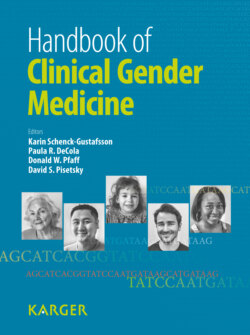Читать книгу Handbook of Clinical Gender Medicine - Группа авторов - Страница 111
На сайте Литреса книга снята с продажи.
The X Chromosome and Autism Spectrum Conditions
ОглавлениеOne of the best-understood mechanisms producing biased sex ratios in a phenotype is the phenomenon of X-linked inheritance. However, the majority of linkage and association studies of ASC carried out to date have failed to find regions of interest on the X chromosome. Mutations associated with ASC have been reported at Xp22.33, Xq13, Xq28, and Xp22.1 affecting the NLGN4, NLGN3, MECP2, and PTCHD1 genes, respectively [22– 24]. In addition, 2 recent genome-wide studies of copy number variation (CNV) in individuals with ASC identified mutations affecting the X chromosome, but this represented a very small subset of cases. Other large CNV scans as well as a recent exome sequencing study have reported no findings on the X chromosome and 3 independent mutation screening studies of NLGN4 and NLGN3 have concluded that mutations in these genes are very rarely associated with ASC [see 4 for review]. In summary, at present it appears that there are X-linked causes of ASC, but these represent a relatively small percentage of cases.
Even if X-linked inheritance does not play a major role in the biased sex ratio seen in ASC, the sex chromosomes exhibit numerous interesting complexities that could play a role in sex differences in ASC. For example, although females have 2 X chromosomes, only one of these is generally active. X chromosome inactivation (the process by which one X is suppressed while the other remains active) acts to negate the ‘dosage’ difference in X chromosome genes between males and females. Inactivation does not involve the same X chromosome in all cells, meaning that females are all epigenetic mosaics. Mosaicism could potentially act as a protective factor if X chromosomes carrying deleterious mutations were preferentially inactivated. Gong et al. [25] tested this hypothesis and found no evidence for skewed X chromosome inactivation in a large sample of individuals with and without ASC.
Up to 20% of the genes on the human X chromosome may continue to be expressed from the ‘inactive’ X, although a recent gene expression study found that only 5% of X-linked genes actually achieve significantly higher expression levels in females compared to males [26]. These genes could play a role in sex ratios if the nonsilenced genes were protective. Girls with Turner syndrome (TS), which is characterized by the XO karyotype and who are haploinsufficient for these gene products, are at an increased risk for ASC; XYY and XXYY males, however, are also at an increased risk. Comparing the incidence of ASC across different sex aneuploidies does not suggest a simple dosage effect; since the ASC frequently occurs in the context of clear learning disabilities, it could simply be secondary to the latter.
Finally, the X chromosome could affect ASC risk through parentally imprinted genes. Genomic imprinting refers to a process by which genetic effects are influenced according to whether the genes are transmitted through the father or the mother. Ordinarily, this would not result in sex differences, but it will if the imprinting affects the X chromosome. It has been suggested that an imprinted X-locus may explain sex differences in social and communicative skills and the male vulnerability to ASC. This theory was inspired by the finding that, in individuals with TS, social problems are greater when the single X is maternal in origin. Typical females always inherit an X chromosome from both parents, but typical males always have only a maternal X. Creswell and Skuse [27] reported 5 cases of ASC from an unselected sample of 150 subjects with TS. All of the affected cases were Xm or had a structurally abnormal paternal X. While this was an exciting finding, it should be kept in mind that 77% of TS females are Xm, while only 23% are Xp, meaning that by chance alone one would expect to find ASC in association with Xm more often than with Xp. In addition, all of the ASC cases in that report had low verbal IQ scores despite the fact that intelligence is usually in the average range in TS, raising the possibility that the ASC was secondary to intellectual disability.
It is also notable that some of the ASC cases had a structurally abnormal paternal X. TS individuals with small ring X chromosomes often have a severe phenotype that is not typical of TS and includes intellectual disability. In these individuals, the loss of the XIST gene, which is involved in causing X-inactivation, may allow for normally inactivated genes to be expressed, resulting in functional disomy. Finally, the presence of residual Y chromosome sequences in a subset of cells in the brain could explain the greater vulnerability of Xm TS females to social dysfunction, but this hypothesis is untestable without access to brain tissue. Bruining et al. [28] examined whether parent-of-origin of the X chromosomes relates to autistic traits in individuals with Klinefelter syndrome (XXY). The hypothesis of Creswell and Skuse [27] would suggest that Xm XmY males show more autistic traits than Xm XpY males, but this was not the case for Autism Diagnostic Interview-Revised (ADI-R) core domain scores.
